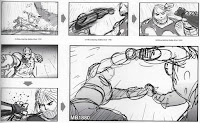
After pitching our idea to Matt, although there were many aspects he liked the pitch was overall given a red light and we could not proceed to further plan the thriller. Upon this we decided to scrap the idea completely and begin from scratch because we wanted to let go of our idea to create something truely thrilling. Although the idea itself became completely different it only took 1 lesson to find certain elements from the original and keep it and create a new idea.

We decided that we particularly liked and enjoyed the concept of a man going about his business that is completely hidden from his family which is shown through the phone call. We wanted to keep this idea but change what her's hiding. Instead of him secretly being a killer and targeting women, we decided that he should be an assasin/sniper meaning he is a dangerous man which contrasts the family man the audience will see on the phone. We liked this because there was something rather thrilling to us about the concept of a man being so casual to his family and not having a care about his brutality which we believed would be very captivating.
We chose for him to be a sniper because that gives the impression of a highly skilled individual, and watching him go from the sweet family guy to the asassin. To become a sniper takes alot of training and being secretive giving a suggestion that he has been hiding this for a long time.
My group and i took the phone call concept and family concept from our originally constructed idea but fixed it with the slight cliche of guns being thrilling to create one of Kristians orginal ideas. We pitched this to Matt and immediately got a thumbs up on the idea, however he warned us to be cautious of when we write the script as the casual-ness may lead to a slight implication of comedy as appose to thriller.

 The sniper as a character is a younger man in his 20-30s who has recently taken up the career of a sniper. Although part of a highly respected organisation he has not informed his wife of his career, he lies. He pretends to be working in an office as a business man to keep it from his family, he covers up any weakness and shows passion towards his job and never wants to quit although he is scared and does not want to harm anyone because he is a family man. He puts up a barrier for himself so he can learn to be brutal and keep to his mind that work is work. The man is easily respected and has authority over many of the people in the organisation, yet he is the one that is put down for his typical unprofessional behavior meaning he needs to be put right and motivated to complete a task. His physical appearance should reflect a tall young man with longer hair, dressed entirely in black. Therefore we cast Mike.
The sniper as a character is a younger man in his 20-30s who has recently taken up the career of a sniper. Although part of a highly respected organisation he has not informed his wife of his career, he lies. He pretends to be working in an office as a business man to keep it from his family, he covers up any weakness and shows passion towards his job and never wants to quit although he is scared and does not want to harm anyone because he is a family man. He puts up a barrier for himself so he can learn to be brutal and keep to his mind that work is work. The man is easily respected and has authority over many of the people in the organisation, yet he is the one that is put down for his typical unprofessional behavior meaning he needs to be put right and motivated to complete a task. His physical appearance should reflect a tall young man with longer hair, dressed entirely in black. Therefore we cast Mike.
 The watcher is a much older man roughly in his 50-60s, he has had a long time in the organisation and despite having the lesser important job to do he is the man that likes to be in charge and knows he is the most experienced in the organisation. The man is very focused on the job because it is all he knows and he gets agitated by the people who do not take it seriously. The watcher elected the sniper because he believes in him, he says things exactly how they are and questions peoples true ability until it is completely proved. The physical appearance for this character follows an older man with grey hair, glasses, a tall slender body also dressed in black. Therefore we cast Ezra.
The watcher is a much older man roughly in his 50-60s, he has had a long time in the organisation and despite having the lesser important job to do he is the man that likes to be in charge and knows he is the most experienced in the organisation. The man is very focused on the job because it is all he knows and he gets agitated by the people who do not take it seriously. The watcher elected the sniper because he believes in him, he says things exactly how they are and questions peoples true ability until it is completely proved. The physical appearance for this character follows an older man with grey hair, glasses, a tall slender body also dressed in black. Therefore we cast Ezra.









